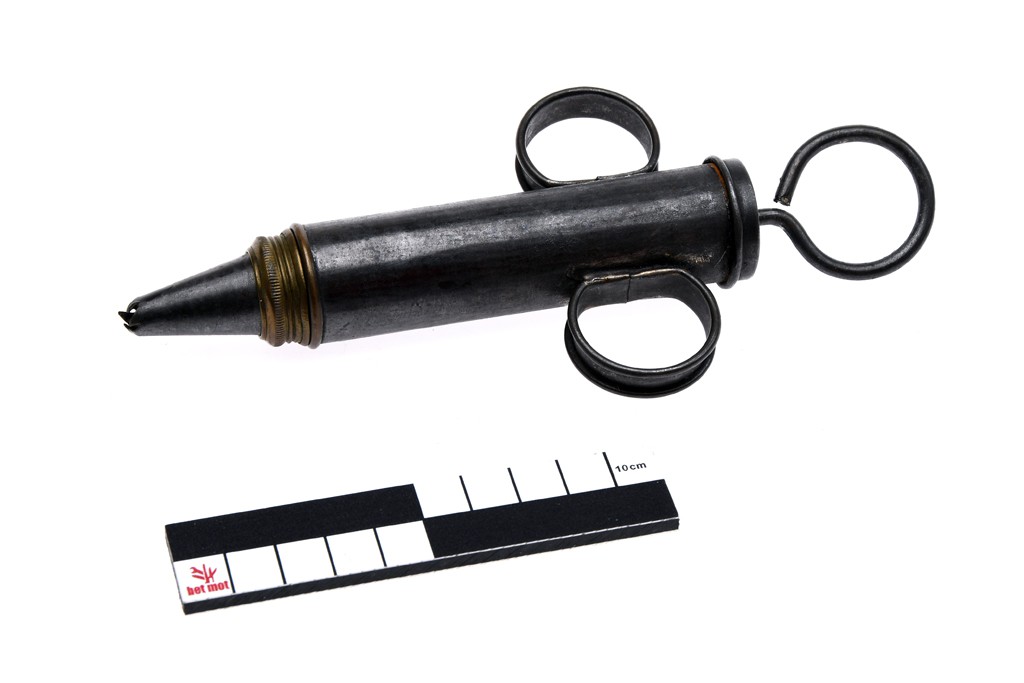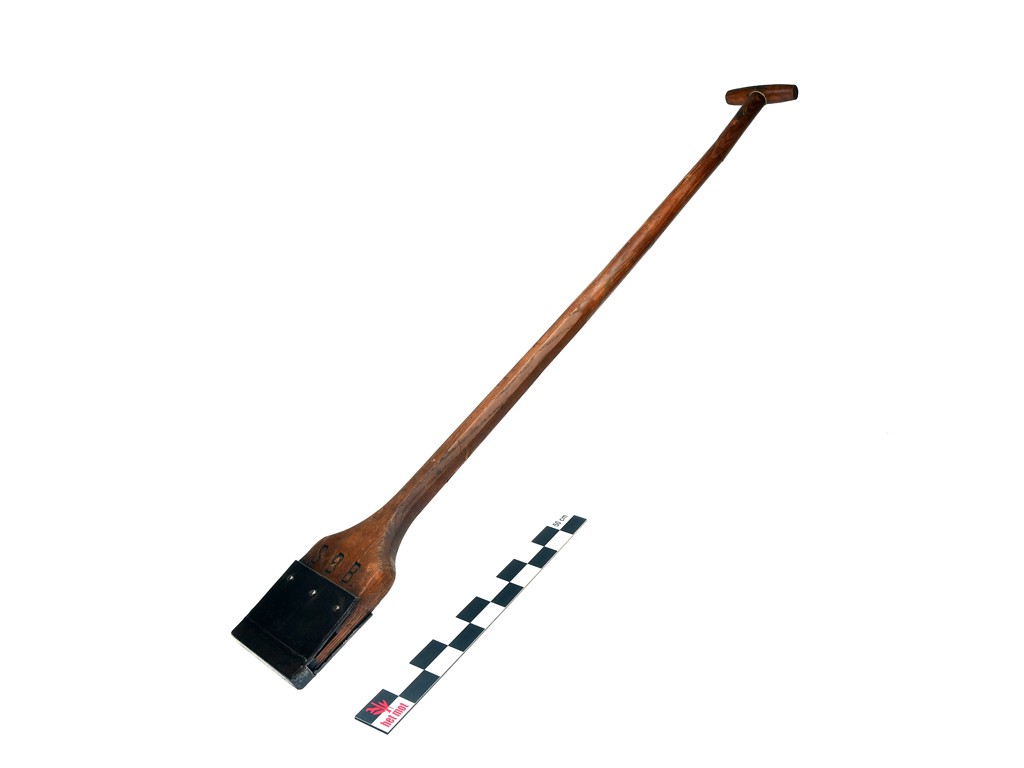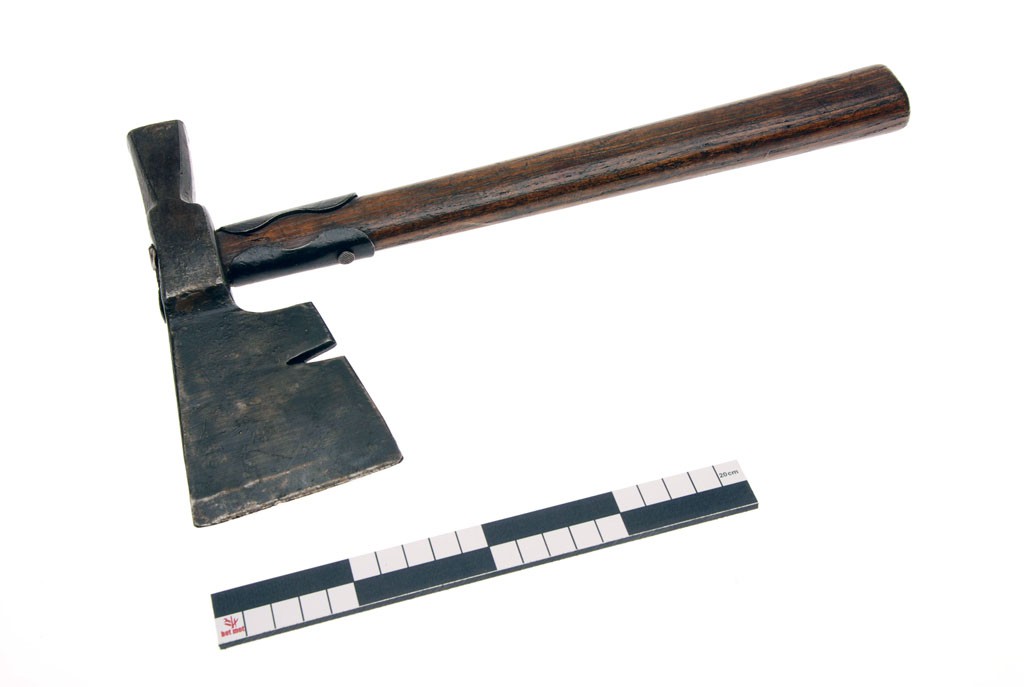ID-DOC: general search
Here you can enter a general keyword and perform a general search.
??? What are these question marks doing here? These represent tools which we know by a Dutch or French name, but who's English name is yet unknown. Suggestions are always welcome!
If you cannot find a certain tool, or if you experience other problems with this page, please let us know at info@mot.be.
Search for: tool
Showing search results 751 - 800
1,487 results found

Icing syringe
This text can only be consulted in Dutch
<https://www.mot.be/resource/Tool/icing-syringe?lang=nl>

Incising knife
This text can only be consulted in Dutch
<https://www.mot.be/resource/Tool/incising-knife?lang=nl>

Increment borer
The age of a living tree can be determined with an increment borer (1). This hand tool is mainly used by the forest ranger, the arborist and the dendrochronologist. More technical information on the dutch version of this page. [MOT](1) HUGGARD & OWEN, Forest tools and instruments, 1960: 48.

Infantry scoop
Infantry scoop of the military. This text can only be consulted in Dutch.
[MOT]

Insinglass besom
Insinglass besom (1). The description is only available in dutch. [MOT] (1)
Proper name unkown.

Insulation knife
This text can only be consulted in Dutch
<https://www.mot.be/resource/Tool/insulation-knife?lang=nl>

Insulation pipe bender
This text can only be consulted in Dutch
<https://www.mot.be/resource/Tool/251?lang=nl>

Insulation pipe cutter
This text can only be consulted in Dutch
<https://www.mot.be/resource/Tool/318?lang=nl>

Iron (solid metal)
This text can only be consulted in Dutch
<https://www.mot.be/resource/Tool/646?lang=nl>

Jack plane
The Jack plane is a planer with a square, 50-60 cm long block, with handle,
without turning chisel. It is the first plane used to smooth a piece of
wood. Since it is intended for rough work, the edge of its chisel is
slightly rounded. Then the wood is processed with a jointer plane. [MOT]

Jar opener
This text can only be consulted in Dutch
<https://www.mot.be/resource/Tool/jar-opener?lang=nl>

Jar wrench
This text can only be consulted in Dutch
<https://www.mot.be/resource/Tool/jar-wrench?lang=nl>

Jewelers' hammer
The jeweler's hammer is a small (approx. 15-25 cm) and light (approx.
50-100 g) hammer. The head (approx. 7-10 cm) has one wedge-shaped end and
one circular or square (approx. 1 cm). The handle is made of wood. Another
model is all-metal with a short, round handle. The goldsmith uses this
hammer to perform very fine and precise work, such as embossing. [MOT]

Jigger
Read the article on continental jiggers of the carriage maker.

Joiner's hammer
This text can only be consulted in Dutch
<https://www.mot.be/resource/Tool/joiners-hammer?lang=nl>

Joiner's mallet
Wooden, rectangular hammer with short handle, usually made of beech or
vinegar. Sometimes the head may be slightly bowed. The carpenter uses this
hammer for various hammering or chiselling work, to close mortise and tenon
joints, etc.See also the joiner's hammer. [MOT]

Jointer plane
The jointer plane is a plane up to one meter long with a turning chisel, a
handle and sometimes a horn. It serves to plan perfectly smooth long pieces
already worked with the jack plane. Sometimes one or two cross poles are
attached on or in the block in order to be able to work in pairs: one
craftsman pushes, another pulls. Sometimes a rope is tied to the front
crossbar. Because this plane has to do fine work, the angle of the chisel
is quite large and the space for the cut is small. The latter is completely
straight, only the corners are rounded so as not to leave any traces. [MOT]

Kerbstone tamper
This text can only be consulted in Dutch
<https://www.mot.be/resource/Tool/kerbstone-tamper?lang=nl>

Key for cream seperator
This text can only be consulted in Dutch
<https://www.mot.be/resource/Tool/key-for-cream-seperator?lang=nl>

Key for roller skates
Small box spanner combined with two ring spanners or with a screwdriver,
with which the roller skater adjusts his skates to his shoes (1). Another
model consists of a small (approx. 12 cm) thin double ring spanner. [MOT]
(1) These are skates that are attached to the shoes by means of straps.

Key for safety fuse type DIAZED
More technical information on our dutch pages. See also these safety fuse
pliers. [MOT]

Key for soil auger
This text can only be consulted in Dutch
<https://www.mot.be/resource/Tool/key-for-soil-auger?lang=nl>

Kitchen scraper
This text can only be consulted in Dutch
<https://www.mot.be/resource/Tool/spatula-kitchen?lang=nl>

Knife (square paving-tile maker)
With this knife, the tile maker cuts off the excess clay around the tile
mould.The hand tool consists of a thin rectangular trapezoidal iron blade
with a cylindrical wooden handle at the top of the short side. The cut is
always longer than the mould.This knife is not used for cutting, but is
pushed diagonally forward and down along the side of the tile mould.
[EMABB]

Knife board
This text can only be consulted in Dutch
<https://www.mot.be/resource/Tool/knife-board?lang=nl>

Knife cleaner
This text can only be consulted in Dutch
<https://www.mot.be/resource/Tool/knife-cleaner?lang=nl>

Knife sharpener
This text can only be consulted in Dutch
<https://www.mot.be/resource/Tool/knife-sharpener?lang=nl>

Lace cutting knife
This hand tool resembles a rectangular stopping knife, but has a stiff
blade ending at a 45 ° cutting angle. The leather worker, especially the
shoemaker, uses the knife to split, plane, or bevel leather, depending on
how he holds the knife. When splitting, the blade is held horizontal to cut
into the thickness of the leather. When planing or cutting diagonally, the
knife is held at an angle to the leather surface. As far as its purpose is
concerned, the knife can be compared to a shoe knife. The tool can be
distinguished from the skiver. [MOT]

Lace-tag fitter
This text can only be consulted in Dutch. See also the aglet pliers. [MOT]

Ladle
Soup, sauce, batter and the like are stirred and scooped with a ladle. It
has a bowl-shaped metal blade on a straight long handle that often ends in
a hook or eye. Sometimes the ladle has a wooden handle. The handle is long
to reach the bottom of a deep pan. The size varies (approx. 8-16 cm
diameter; approx. 25-63 cm long). To be distinguished from the lead spoon.
[MOT]

Lamp trimmer
This text can only be consulted in Dutch
<https://www.mot.be/resource/Tool/lamp-trimmer?lang=nl>

Lard kettle
This text can only be consulted in Dutch
<https://www.mot.be/resource/Tool/lard-kettle?lang=nl>

Lard press
This text can only be consulted in Dutch
<https://www.mot.be/resource/Tool/lard-press?lang=nl>

Larding needle
This text can only be consulted in Dutch
<https://www.mot.be/resource/Tool/larding-needle?lang=nl>

Larding pin
To pull small strips of bacon through lean roast, you can use a larding
needle or a larding pin. The latter has a long (approx. 30-40 cm) and
narrow semi-cylindrical shaped blade with a sharp point, fixed in a wooden
or plastic handle. A strip of bacon or some chilled fat is placed in the
tray after the larding pin has been cut right through the meat. When you
pull back the larding pin, it is turned over and the fat is left in the
meat. The larding pin used on large cuts of meat would have a spring and
lever to cut the strips and hold them in place (1). The trussing needle and
larding pin are kept in a typical set of 2 needles and 12-15 awls of
different sizes (2). [MOT] (1) "Nouveau Larousse ménager": 693. (2)
CHANCRIN & FAIDEAU: 736.

Last hook
This text can only be consulted in Dutch
<https://www.mot.be/resource/Tool/last-hook?lang=nl>

Lathing hatchet
The lathing hatchet is a light hatchet - distinguishable from the roofer's
hammer - of approx. 750 g with eye and with straight, relatively thin
handle (approx. 30 cm), the iron of which, attached by one or two metal
supports, ends in a square hammer opposite the blade. The top side of the
blade is usually straight. In the underside one (sometimes two) notches is
often forged to pull out nails. The cut is straight. Sometimes the whole
tool, including the handle, is made of metal; the end of the stem is then
placed in leather discs or in a wooden handle. However, these shapes seem
to be rare in our regions. [MOT]

Lattice cutter
This text can only be consulted in Dutch
<https://www.mot.be/resource/Tool/lattice-cutter?lang=nl>

Laundry beater
In the past, the actual washing was done after the laundry was cooked. The lye and the already dissolved dirt, as well as the last stains had to be removed with soap. This was done by hand alone, on a washboard or with a laundry beater (approx. 30 by 10 cm). The latter is a wooden chip-shaped beater - to be distinguished from the cork driver and the iron beater - with which the laundry was tapped, which was placed on a stone or shelf. [MOT

Laundry scrubber
This text on the laundry scrubber can only be consulted in Dutch. [MOT]

Laundry tongs
Hot laundry could be safely removed from the washing kettle with these
laundry tongs. They were usually made of (beech) wood because it does not
stain, is light and cheap. The metal parts such as the spindle or spring
were often made of copper, because the tongs were certainly not allowed to
rust. However, there are also iron and rubber or plastic laundry tongs.
[MOT

Lawn aerator (roller)
A lawn that is frequently used remains a beautiful green if it is
cultivated with a lawn aerator. By preventing compaction of the soil,
enough air, water and fertilizers are admitted to the roots. There are
various means of aerating the lawn. One model of lawn aerator consists of
two wheels that are connected to each other by 6 rods (approx. 35 cm),
fitted with iron pins (approx. 8 cm; diam. 0.6 cm), and a bracket with
protective cover and stem (approx. 100 cm). When the implement is pushed
over the lawn, the pins - every 5-10 cm - end up in the ground at an angle
of about 30 ° and are a suspension system put back in place. Another model
is simply a spiked wooden roll that is a bracket is attached to a wooden
shaft (1). For a small lawn you can also use aerator shoes. It is even more
labor-intensive if you use a lawn aerator (spike). The tool - resembling a
dibble - is provided with 2 to 4 conical or hollow cylindrical teeth
(length approx. 5-10 cm; diam. Approx. 1 cm), which can be moved...

Lawn comb
This text can only be consulted in Dutch
<https://www.mot.be/resource/Tool/lawn-comb?lang=nl>

Lawn mower (hand)
This text can only be consulted in Dutch
<https://www.mot.be/resource/Tool/lawn-mower-hand?lang=nl>

Lawn rake
This text can only be consulted in Dutch
<https://www.mot.be/resource/Tool/lawn-rake?lang=nl>

Lawn sweeper
This text can only be consulted in Dutch

Lawn wire rake
This text can only be consulted in Dutch
<https://www.mot.be/resource/Tool/lawn-wire-rake?lang=nl>

Lead came mill
This text can only be consulted in Dutch
<https://www.mot.be/resource/Tool/lead-came-mill?lang=nl>

Lead hammer
This text can only be consulted in Dutch
<https://www.mot.be/resource/Tool/lead-hammer?lang=nl>

Lead pipe expanding pliers
This text can only be consulted in Dutch
<https://www.mot.be/resource/Tool/266?lang=nl>
